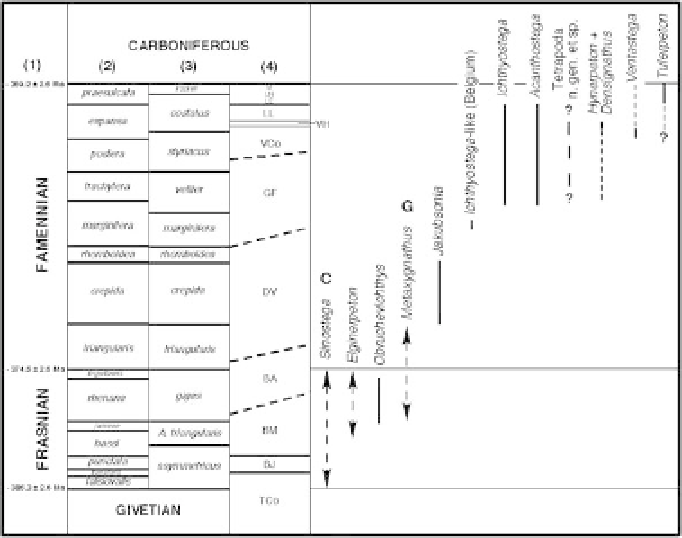Geoscience Reference
In-Depth Information
in age, but most probably Frasnian; Elginerpeton
(Scotland) which is middle or late Frasnian in age;
and Metaxygnathus (Australia) which is Frasnian
or Famennian. All the taxa were plotted against
the southeastern Euramerican miospore zonation
(Blieck et al. 2007, fig. 1). However, new data
have been published since that publication.
Among them, the southeastern Euramerican
miospore zonation has been completed for the tran-
sitional late Frasnian to early Famennian time slice
(Streel 2009). The interval of informal biozones IV,
V and poorly defined biozone GH used by Blieck
et al. (2007, fig. 1) is replaced by the two newly
defined Oppel Zones BA and DV (Fig. 1). The
Oppel Zone BA is subdivided into three new
interval zones. Its uppermost subdivision, the plic-
abilis interval zone, extends across the Frasnian -
Famennian boundary (Streel 2009).
Note that the vertical bars of Figure 1 (where the
radiochronologic scale has been updated after Grad-
stein et al. 2004) do not correspond to the actual age
distribution of tetrapods, but to the age duration of
conodont or spore zones in which the taxa have
been collected (Marshall et al. 1999). Because
most early tetrapod finds are from only a single
stratigraphical horizon, their fossil record is more
sparse than what is indicated by Figure 1. The
exception to this is in East Greenland (for Ichthyos-
tega, Acanthostega and the new genus and species)
where the sampling has been much more abundant
(review in Blom et al. 2007).
Comments on the East Greenland localities
The recent paper of Blom et al. (2007) has reviewed
the stratigraphical distribution of vertebrates in the
Old Red Sandstone series of the east coast of Green-
land and provides additional information on the age
of the tetrapods. Fossiliferous localities are on
Gauss Peninsula (Gauss Halvø) and Ymer Island
(Ymer Ø). They have provided 50 different ver-
tebrate taxa for the Middle and Upper Devonian
(Blom et al. 2007, fig. 2), including the most diver-
sified Late Devonian tetrapod fauna with Acanthos-
tega gunnari, three species of Ichthyostega (I.
stensioei, I. watsoni, I. eigili after the revision of
Blom 2005) and a third, yet undescribed genus
(Clack et al. 2004).
Contrary to our proposal (Blieck et al. 2007,
fig. 1), both Acanthostega and Ichthyostega have
the same stratigraphical distribution which spans
the upper part of the Famennian from the Aina
Fig. 1. Revised biostratigraphical distribution of Devonian tetrapods after Blieck et al. (2007). Each vertical bar
illustrates the age duration of the conodont or miospore zones in which the corresponding taxon has been collected.
Dashed lines with arrows indicate uncertainties in dates. (1) Radiochronologic scale of Gradstein et al. (2004, fig. 14.2);
(2) standard conodont zones of Ziegler & Sandberg (1990, fig. 1); (3) older conodont zones after Ziegler & Sandberg
(1990); and (4) miospore zones in the eastern part (now west Europe) of the south Euramerican area after Streel
(2009). Palaeogeographic occurrences: C: North China; G: East Gondwana (Australia); all others are from the Old Red
Sandstone Continent (Euramerica, Laurussia, Laureuropa).

